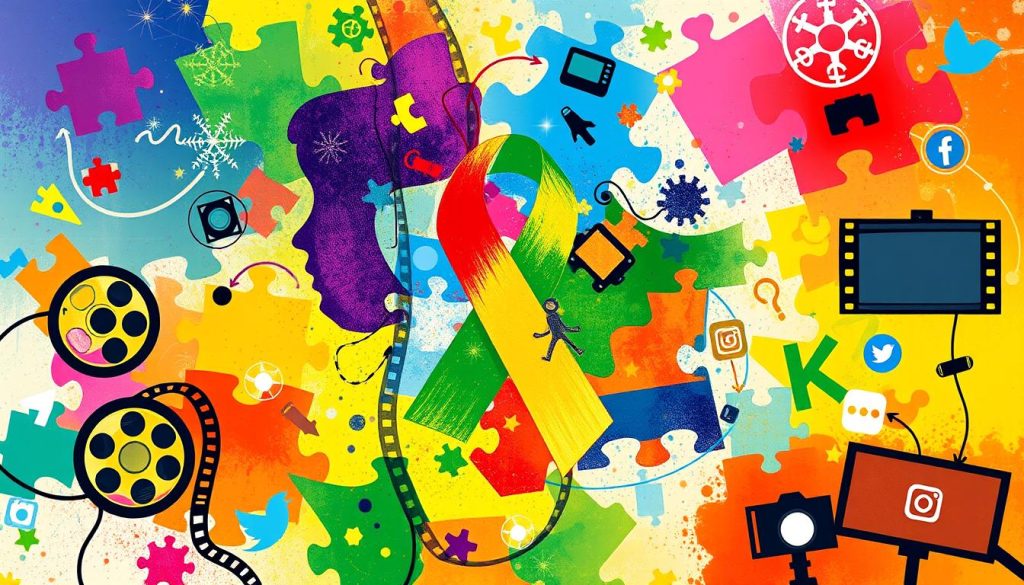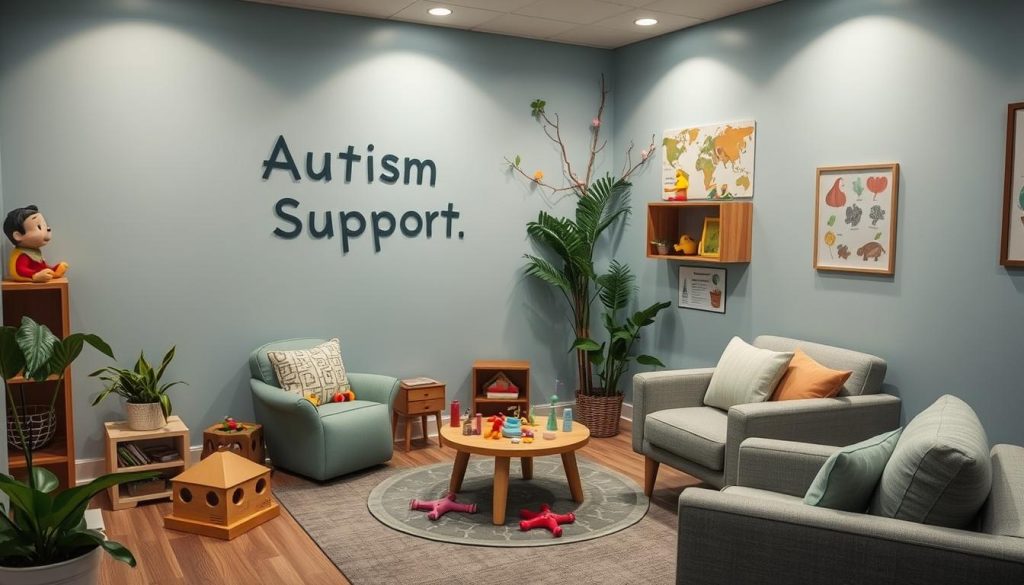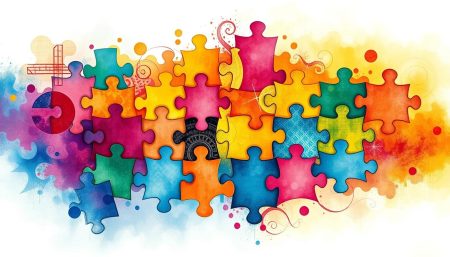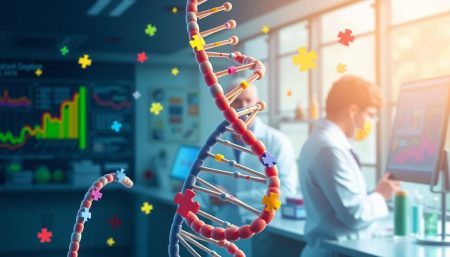Autism Spectrum Disorder (ASD) affects many areas of life, not just for those with it but also for their families and communities. With more people being diagnosed with ASD, it’s more important than ever to raise autism awareness and provide autism spectrum disorder support. We’re diving into the world of ASD to learn about the different experiences and challenges people face.
Our goal is to understand the autism causes and the unique aspects of each case.
Creating a supportive environment is key. It helps break down barriers, supports effective care, and celebrates the unique abilities of each person. This article aims to help you understand ASD better. It offers valuable insights on care, community involvement, and how to improve the lives of those on the spectrum.
What Is Autism Spectrum Disorder?
Autism Spectrum Disorder (ASD) is a complex condition that affects how people interact and communicate. It also impacts their behaviors. The symptoms of ASD can vary greatly from person to person. They are often noticed early in childhood and can affect daily life.
The Basics of ASD
The term ‘spectrum’ in autism spectrum disorder shows the wide range of challenges and strengths in each person. Children with ASD may develop differently than their peers. ASD affects how a person sees and interacts with others, leading to social and communication problems.
It also includes repetitive behaviors. Symptoms of autism can include trouble with communication, social interactions, and a preference for routines. These behaviors can be different for everyone.
Range and Diversity Within the Spectrum
No two people with ASD are the same. Their symptoms can range from mild to severe. While all people with autism face certain challenges, how these challenges affect them can vary greatly.
Some may need a lot of support, while others may need less. Understanding this diversity is key to providing the right support. It shows why personalized care is important for managing ASD.
Signs and Symptoms of Autism
It’s key to know the signs of autism early for better outcomes. This part talks about how symptoms show up at different ages. It shows why getting a diagnosis early and starting treatment early is so important.
Recognizing Early Signs in Children
Children with autism might have trouble with social interactions, talking, and doing things over and over. Parents might see a child not answering when called, not looking at them, or playing in odd ways. Starting treatment early can help a lot because young brains are more flexible and can learn new things.
How Symptoms May Present Differently in Adults
Adults with autism might show symptoms in different ways or hide them. They might struggle with social interactions, be very sensitive to sounds or lights, or stick to routines very closely. Spotting these signs in adults is key for getting the right help and support.
Knowing how autism symptoms change with age helps in getting the right help. Here’s a look at what to watch for in kids and adults.
| Early Signs in Children | Adult Symptoms |
|---|---|
| Limited or no eye contact | Difficulty maintaining friendships |
| Delayed speech and language skills | Challenges with nuanced communication (e.g., idioms) |
| Lack of interest in peer relationships | Over-reliance on routines and schedules |
| Repetitive use of objects or speech | Heightened sensory sensitivities (e.g., to lights or sounds) |
Exploring the Causes of Autism
Understanding autism’s causes is complex, involving genetics and environment. While we don’t know everything, research is helping us learn more. This section looks at what science has found so far.
Genetics are a big part, with studies showing a link to autism. But, it’s not the only thing. Things like chemicals, birth issues, and parents’ age also play a role.
Let’s break down the causes of autism:
| Factor Type | Examples | Impact |
|---|---|---|
| Genetic | Family history, gene mutations | Direct, often heritable influence on likelihood of developing autism |
| Environmental | Prenatal exposure to toxins, maternal health conditions | Modulates risk during key developmental windows |
Families and professionals need good autism resources. These resources offer important info, support, and guidance. They help those affected by autism face the challenges they meet.
Many online sites, non-profits, and support groups are out there. They provide the latest research, educational materials, and community support. This makes life easier for families dealing with autism.
‘autism spectrum disorder-‘ – Unpacking the Terminology
The term “autism spectrum disorder” has changed a lot over time. It shows how our understanding and approach to autism have grown. By looking at how this term has evolved, we learn a lot about supporting the autism community.
Understanding the Diagnostic Criteria
Doctors use specific criteria to diagnose autism. These criteria check on social skills and repetitive behaviors. The DSM-5 manual helps ensure diagnoses are accurate and consistent.
Changes in these criteria have helped improve how we see and support autism. This has made a big difference in how individuals get the help they need.
The Evolution of the ASD Diagnosis
How we diagnose autism has changed a lot. At first, it was seen in a very narrow way. Now, we understand that autism can show up in many different ways.
This change shows how important research and new methods are. They help us better understand and support people with autism.
Early Intervention for Autism and Its Importance
Understanding the role of early intervention for autism is key for kids with autism spectrum disorder (ASD). Starting autism therapy early can boost their skills in thinking, socializing, and talking.
Early intervention for autism uses many therapies to help a young child’s brain grow. Studies show it greatly improves how kids develop overall.
- Development of communication skills
- Enhancement of social interactions
- Improvement in self-care abilities
These therapies, like changing behaviors and playing, are part of a wide approach. They aim to lessen the challenges of ASD.
| Age of Intervention | Expected Benefits |
|---|---|
| Under 3 years | Optimal development in speech and cognitive behavior. |
| 3-5 years | Improved social skills and better adaptation to preschool. |
| 5-8 years | Enhanced learning abilities and peer interaction. |
Success in early intervention for autism depends on plans made just for each child. It’s important for health care providers, parents, and teachers to work together.
- Behavioral therapy
- Speech therapy
- Occupational therapy
Knowing how early intervention can change a child’s life is powerful. It gives them a chance at a more independent and happy life.
Autism Diagnosis Process and Challenges
Finding out if a child has autism is a tough and emotional journey for families. It’s important to know the steps and find the right autism spectrum disorder support.
Steps in the Diagnostic Journey
Getting an autism diagnosis involves several stages. Each step is important for a complete check-up. A team of experts works together to assess the child.
- Initial Screening: Doctors use special tools to check if a child is developing as expected.
- Detailed Evaluation: A neurologist, psychologist, or psychiatrist does a deeper check. They look at behavior and talk to parents.
- Complementary Assessments: Occupational and speech therapy might be suggested to see how other areas are affected.
Families need to be ready and informed for each step.
Navigating Emotional Responses to Diagnosis
When a family gets an autism diagnosis, they might feel many things. They might feel relieved and unsure at the same time. They really need support and guidance.
- Finding Resources: Counseling and support groups can help manage feelings.
- Educating Oneself and Family: Learning about autism spectrum disorder helps cope and plan for the future.
- Connecting with Other Families: Sharing experiences and tips in community groups or forums.
Looking for help and support early on can make the transition easier. It helps families cope better.
The Role of Genetics and Environment in Autism
The mix of genetics and environment is key to understanding autism causes. Studies show that while genes play a big role, the environment also has a big impact. Knowing this helps improve autism resources and support.
Genetics are a starting point. If a family member has autism, others might be more likely to have it too. But, things like toxins, pregnancy issues, and infections during pregnancy also matter a lot.
- Evidence has shown that what a mother eats and the air she breathes during pregnancy can affect autism.
- The first few months after birth are very important. Things like the parents’ age, health, and where they live can make a difference.
Grasping how genes and environment interact helps us understand autism causes better. It also makes autism resources more effective. This approach leads to better ways to help people with autism, whether they’re kids or adults.
Autism Treatment Options and Therapies
There are many effective autism treatment options and therapies. Each one is designed to meet the unique needs of individuals. These therapies aim to help those with autism spectrum disorder (ASD) in different ways. Thanks to these therapies, many people with ASD now live better lives.
Behavioral Interventions and Their Impact
Behavioral therapies are key in treating autism. They include Applied Behavior Analysis (ABA), which helps improve good behaviors and reduce harmful ones. With the help of skilled therapists, these methods have greatly helped people with autism develop better communication and social skills.

Speech and Occupational Therapy for ASD
Speech therapy is essential for improving communication skills in those with autism. It’s often combined with occupational therapy. This helps with daily tasks and enhances motor skills and sensory integration. Together, these therapies help individuals with autism become more independent and function better in daily life.
- Individualized autism therapy plans tailored to specific needs.
- Interdisciplinary teams to provide a complete autism treatment.
- Use of advanced technology and tools to improve therapy results.
Supporting Loved Ones with Autism Spectrum Disorder
Living with someone who has Autism Spectrum Disorder (ASD) is a big responsibility. It needs commitment, understanding, and special strategies. Making the home autism-friendly can greatly improve their life.
Caregiver Strategies for Daily Life
Managing daily life with ASD means having clear routines and expectations. This helps reduce stress for both the person with autism and the caregiver. Using simple language or visual aids is key in supporting them.
Creating a sense of security and predictability at home is also important. It helps deal with the common challenges of sensory sensitivities in autism.
Creating an Autism-Friendly Home Environment
Creating a safe and welcoming home is vital for those on the autism spectrum. Designing the home to be sensory-friendly is essential. This includes reducing clutter, using calming colors, and setting up areas for sensory play or relaxation.
These changes can help reduce sensory overload and make the home more comfortable.
Here are some key adjustments to make a home autism-friendly.
| Area | Adjustments |
|---|---|
| Living Room | Use soft lighting, keep noise levels low, provide comfortable seating options like bean bags or soft chairs |
| Bedroom | Implement blackout curtains for better sleep, use weighted blankets to reduce anxiety, keep decor simple and unobtrusive |
| Kitchen | Label cabinets and drawers for easy navigation, use visual schedules to outline mealtime routines, ensure all safety locks are in place |
| Bathroom | Install non-slip mats, use automatic soap dispensers and faucets to make them more accessible, maintain an organized and clear space |
Autism and Education: Advocacy and Inclusion
Creating an inclusive school environment is vital for kids with autism. Schools need to be ready to support these students. Advocacy is key to making sure they get the help they need.
Training teachers about autism is a big step. It makes schools more understanding and supportive. Having the right resources helps a lot too.
- Personalized learning plans tailored to individual strengths and challenges of students with autism.
- Communication aids and technology that assist in bridging learning gaps.
- Collaborative educational strategies, involving parents and specialists to optimize learning outcomes.
Changing policies is also important. It helps make schools more welcoming for kids with autism. This can lead to more funding and better education for all.
| Advocacy Focus | Goals | Impact |
|---|---|---|
| Teacher Training | Equip educators with autism-specific skills | Enhanced understanding and support in schools |
| Policy Change | Secure funding and resource allocation | Wide-scale improvement in educational access and quality |
| Community Partnership | Involve community resources and support networks | Sustainable support system outside traditional schooling |
In conclusion, working together is essential. Schools, communities, and policymakers must advocate for better education. This way, students with autism can get the education and respect they deserve.
Resources and Organizations for Autism Support
Families and individuals with autism need dedicated support. This section will look at autism resources and how they help connect you with support. Knowing these options can make a big difference in getting the help you need.
Connecting with Local Communities
Local communities are key for autism resources. Many cities have groups that hold meetings, workshops, and events. These groups help share experiences and provide local resources for everyday challenges.
Utilizing Online Resources for Assistance
The internet is a great tool for autism spectrum disorder support. Websites, forums, and social media groups offer information and advice. They help people feel less alone by connecting them with others who understand.
Digital and physical spaces for autism are very important. They provide the support and resources needed.
| Type of Support | Description | Examples |
|---|---|---|
| Local Community Groups | These groups offer in-person support through meetings, social events, and education. | Autism Society chapters, local non-profit organizations |
| Online Forums and Websites | Online platforms provide 24/7 access to support, advice, and the latest autism research. | Autism Speaks forums, Wrong Planet forums |
| Social Media Groups | These groups help connect individuals with autism and their families all around the globe. | Facebook groups dedicated to autism support |
Social Perception and Autism Awareness
Improving autism awareness and debunking myths are key to changing how people view autism. Understanding the role of autism resources and awareness efforts helps shift community attitudes. This shift moves towards acceptance and support.
Public Misconceptions and How to Address Them
Many misconceptions about autism remain, despite growing awareness. Some believe autism is caused by bad parenting or vaccines. Awareness campaigns are vital in correcting these myths. They use real data and personal stories to challenge these false beliefs.
Role of Media in Shaping Autism Perception
The media greatly affects how people see autism. Sensationalized stories can cause confusion. Yet, the media can also educate with well-researched content. This includes documentaries, articles, and news segments that show the true life of those with autism.
- Encouraging accurate media portrayals of individuals with autism to foster a better understanding.
- Highlighting the diversity within the autism spectrum through various media outlets.

By sharing real stories and verified information, media and advocacy groups can work together. They aim to change perceptions and make society more inclusive for those with autism.
Employment and Career Building for Individuals with ASD
Bringing people with autism into the workforce adds diversity and opens new doors. It’s key to support them in their jobs and career paths. Using special therapy and making work places more accessible can really help them use their skills.
More companies are seeing the value in hiring people with autism. They bring skills like attention to detail and analysis. But, finding a good job can be tough for them. They face special challenges and need certain strategies to succeed.
- Workplace accommodations (flexible schedules, quiet work environments)
- Tailored autism therapy and ongoing support
- Job coaching and peer mentoring programs
Employers must keep giving autism spectrum disorder support. This ensures their workers are happy and do their best.
| Job Sector | Skills Utilized | Examples of Roles |
|---|---|---|
| Technology | Detail-oriented, problem-solving | Software testing, data entry |
| Arts | Creativity, focus | Graphic design, animation |
| Logistics | Organizational, methodical | Supply chain assistant, inventory management |
Every job field can benefit from the talents of people with autism. With the right training and work environment, companies gain a lot. They also support a more diverse team.
Legal Rights and Protections for People with Autism
People with autism spectrum disorder have the same rights as everyone else. They should live without discrimination and have equal chances. In the United States, the Americans with Disabilities Act (ADA) is key to these rights. It stops discrimination based on disability, helping those with autism get support in work, school, and public places.
The ADA makes a big difference for those with ASD. It makes sure schools help with education needs. At work, it stops unfair treatment and helps with job tasks. It also makes public places more accessible for those with autism.
It’s vital for people with autism and their families to know about these rights. There are many resources that offer legal advice and support. Knowing about these laws helps those with ASD fight for their rights and get the help they deserve.
FAQ
Q: What are the key symptoms of autism spectrum disorder?
A: Autism spectrum disorder (ASD) shows in several ways. People with ASD often struggle with social interactions and communication. They also have repetitive behaviors and interests.
Q: How is autism spectrum disorder diagnosed?
A: Doctors diagnose ASD by observing behavior and doing developmental screenings. They might also do genetic tests. This is done by experts like pediatricians and psychologists.
Q: What are some early signs of autism in children?
A: Early signs include not making eye contact and delayed speech. Children might not respond to their name or show little interest in people or play. They might also repeat actions a lot.
Q: Can adults be diagnosed with autism?
A: Yes, adults can get diagnosed with autism. Some might not have been noticed as kids, if their symptoms were mild or hidden.
Q: Why is early intervention for autism important?
A: Early intervention is key because the brain is most flexible when young. Starting therapy early can help with social, communication, and thinking skills.
Q: What are the current theories on the causes of autism?
A: Autism’s causes are not fully known. But, it’s thought that genetics and environment play a role in brain development before birth.
Q: What types of therapies are available for individuals with autism?
A: There are many therapies for autism. These include Applied Behavior Analysis (ABA), speech therapy, occupational therapy, and special education programs.
Q: How can caregivers support adults and children with autism spectrum disorder?
A: Caregivers can help by making environments predictable and using clear communication. They should also work on social skills and support educational and social needs.
Q: What resources are available for individuals with autism and their families?
A: There are many resources out there. These include autism organizations, online forums, therapy centers, and educational materials for families and professionals.
Q: How can we improve public awareness and perception of autism?
A: We can improve awareness through education and community events. Responsible media and advocacy that highlights autism’s strengths and challenges are also important.
Q: What legal protections are in place for people with autism?
A: People with autism have legal protections. Laws like the Americans with Disabilities Act (ADA) ensure equal opportunities in work, school, and public life.
Q: How can employment opportunities be enhanced for individuals with ASD?
A: Jobs can be made better for people with ASD by providing accommodations and training. Employers should also understand and value their unique skills.
Q: How is autism portrayed in the media, and why does it matter?
A: Media can shape how people see autism. Accurate and varied portrayals are important. They help people understand and accept autism better.
Q: How can autism spectrum disorder impact family life?
A: ASD can change family life in many ways. It requires adjusting routines and communication. Families need to learn how to manage and understand autism’s needs.
Q: Are there differences in how autism presents in males and females?
A: Yes, autism can show differently in males and females. Females might hide symptoms better, leading to fewer diagnoses. Their interests might also seem more normal.


















